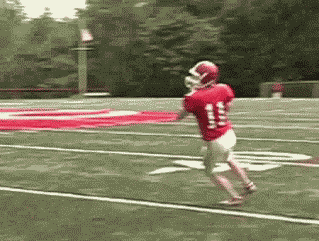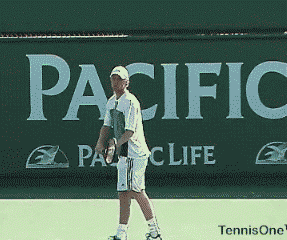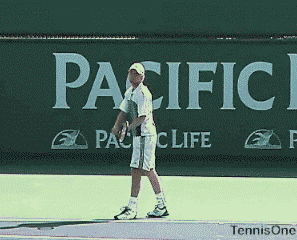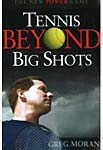| TennisOne Lessons For Godís Sake, Work on Your Serve Greg Moran I’ve always found it interesting that many players are eager to practice their groundstrokes and net game yet avoid working on the serve. As a result, there are literally thousands of recreational players out there who are at the 4.0 level in every aspect of their games, except their serves. When these players attempt to play in 4.0 level leagues or tournaments, this imbalance hurts them and their teams big time. On the other hand, one of my students, James, is solid 3.5 level player but has developed a 4.5 level serve. We play every Saturday morning at 6:30, and James always gets to the club 20 minutes early to practice his serve. As a result, his serve is actually a level above the rest of his game and allows him to hold his own in matches with people who, for the most part, are stronger players The serve is the most important shot in the game of tennis because it is always first shot hit and often sets the tone for the entire point. It’s the one shot in the game where you are totally in control: you can take your time to hit it and you don’t have to react to something your opponent has hit to you. That being the case, your serve should become your biggest weapon and when it does, you’ll able to compete with any player at the club.
It All Begins with the Toss Day after day, I see players contort their arms and bodies like pretzels as they attempt to serve with a toss that is either to far left, too far right, or three feet behind them. It doesn’t work! Remember this: you should not adjust your swing to your toss. You should adjust your toss to your swing. When you develop control over your toss, you’ll automatically move your serve to the next level. A well-placed toss allows you to swing your racquet smoothly and transfer your body weight into the ball. How’s your toss? Let’s find out. Grab your racquet and a ball and go through your service motion, toss the ball and let it drop to the ground. Make a mark, or place a coin, on the spot where the ball lands. Repeat this five times, each time marking the spot where the ball lands. Now, swing your arm in the service motion and stop it in front of your body, at your point of contact. Slowly drop your arm until your racquet head touches the court. This will show you roughly where your service toss should have landed. How many of your tossing marks are in the right spot? Here are two quick tips to help you groove your toss:
Remember, successful tennis strokes are a function of positioning and the positioning aspect of your serve is the toss. A properly placed toss will allow you to swing your racquet smoothly. This will help you to hit a consistent serve that you can control and add pace to when you like.
Throw a Touchdown Pass Your service motion should mirror that of a quarterback throwing a 50 yard pass: up and out with a wrist snap at contact. I once had a student who, without a doubt, had the worst service motion in the history of tennis. Her arm went every which way, and she ended up flicking her racquet at the ball using her elbow and wrist. To call it “ugly” would be kind! After showing her that the proper service motion was like throwing a football, I told her to take fifty practice throws a day. She took the tip to heart and each day practiced throwing a rolled up pair of socks against a wall in her bedroom 150 times! She developed a service motion that was the envy of every player at the club—myself included! Another great exercise to practice your serve is to hold a tennis ball in each hand and go through your service motion. After you’ve tossed the first ball, watch it reach its peak and then throw the second ball and try to hit your toss. This allows you to practice both your toss and swing. You can even do this one in the comfort of your home. Just replace the tennis balls with socks. Make Your Serve a Weapon Boom or bust. This is the way many players approach the serve. They launch a rocket on their first serve, hoping that, if it goes in, they’ll get an easy point as well as intimidate their opponent with their “awesome” power. It’s a freebie in their minds because they know that if it doesn't go in they can always "plop" in the second serve and still be in the point. While this is not necessarily a bad strategy with the weekend wannabes who don’t have the skills to take advantage of a powder puff second serve, a strong player will eat that “plop" second serve for lunch.
There’s much more to a strong serve than merely trying to overpower your opponent. Sure, big serves are nice but service winners for most players are far and few between. A better approach is to view your serve as a tool to gain control of the point. You do this by first getting it in on a consistent basis while also keeping your opponent guessing as to where you’re going to hit it. Players with strong serves have learned to get a high percentage of their first serves in and actually swing just as hard, sometimes harder, on their second. Their secret lies in the use of spin. Spin to Win Spin is nature’s gift to tennis. It enhances both our consistency and control and by learning to put slice and topspin on your serve you’ll keep your opponent scrambling right from the start of the point.
Spin serves are best hit with the Continental grip. This grip puts the racquet at an angle in your hand which, depending upon how you swing your arm and snap your wrist, allows you to make the ball dance. When a right handed player hits a serve with heavy slice (imagining the ball as the face of the clock, make contact at 3:00 and swing around as if you’re peeling an orange) , the ball will hit the court and kick severely to the receiver’s right. A serve hit with severe topspin (swinging up and out from 7:00-1:00) will clear the net by a large margin, making it a “safe” serve, and then kick up in the receivers face. Both spins will force your opponent to hit the ball out of their strike zone and will often result in an error or weak return which you can then attack. Placement is More Important than Power Clemson University’s legendary coach, Chuck Kreise, once said that “power thrills but placement kills” and he is right on the mark. By moving your serve around to different areas of the service box, you’ll keep your opponent guessing. The next time you go to the practice court try this exercise: take twelve tennis balls, put one on top of three, making three small towers. Place one in each corner of the service box and the last one in the middle.
Next, take a basket of balls and start aiming for the towers, one at a time. Tell yourself that you’re going to stay out there until you knock over all of the towers. You’ll probably be out there for quite a while, but if you do this a few times a week, I guarantee you’ll develop an accurate serve. You can also keep your opponent off balance by varying where you stand along the baseline. Pick a spot close to the center line, another mid way between the center line and sideline and a third close to the sideline. When you serve from these three points, it will change the angle that your serve moves towards your opponent, making it more awkward to return. If you can hit your topspin and slice serves to all three areas of the service box from three different spots along the baseline, you’ll have eighteen different serves to throw at your opponent. Plus, if you can throw in the occasional flat serve to all three spots, from all three areas of the baseline, you’ll have 27 different serves at your disposal. That should keep your opponent’s sufficiently confused! Develop a Serving Ritual Each time you step up to the line to serve, you need to relax yourself and clear your head. This is best done by developing a serving ritual. It can be a series of movements such as bouncing the ball a certain number of times, adjusting your hat ala Jim Courier or taking several deep breaths. Here’s Maria Sharapova’s serving ritual:
Develop a personal ritual to go through before every serve. If you’re nervous, go through it twice. It will help you put your mind and body in sync and allow you to focus on hitting your best serve. There is no excuse for not having a strong serve. Take to the court with a big basket of balls and work on:
Be sure to practice all of your serves from both sides of the court as well as from different spots along the baseline. Developing your serve can be a lonely, sometimes boring proposition. However, I can assure you that the type of game an effective serve allows you to play is anything but boring. Your comments are welcome. Let us know what you think about Greg Moran's article by emailing us here at TennisOne.
Tennis Beyond Big Shots presents a bold back-to-the-future approach. A new game that moves away from power and big shots yet is more lethal to opponents than any booming serve. Greg Moran shows players of all ages and abilities that, with simple and small changes, you can not only maximize your tennis wins and play longer, but also have much more fun doing it. Click link to purchase Greg Moran's book, Tennis Beyond Big Shots. Mansion Grove House is pleased to announce that in May2008, they willreleasethe second edition of Tennis Beyond Big Shots.Written by Greg Moran, the book (which includes a new chapter) was Amazon's #1 new tennis release in 2007. |



